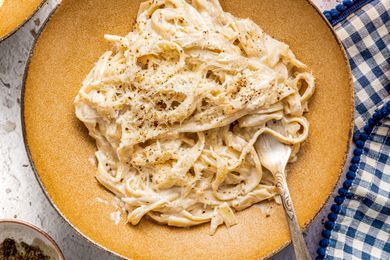:max_bytes(150000):strip_icc()/Simply-Recipes-DIY-Macaroni-Cheese-LEAD-03-3de03194f28d4f54b870daae7d9d5778.jpg)
Simply Recipes / Sara Bir
We love macaroni and cheese in all forms at our house: from scratch on the stovetop, baked in the oven with a crown of buttery breadcrumbs, and especially from a box mix. Those little orange or blue boxes have been my friends since I was a kid. They represented simple, comforting meals I could make myself. Ditto the years I spent as a clueless adult making my way in the world. Before our daughter was born, about once a week her dad and I gloriously slummed it on Trader Joe’s classic macaroni and cheese enriched with cut-up hot dogs and frozen peas.
Now my daughter’s the one who consumes boxed macaroni and cheese as if it were its own food group. I wanted to wrangle a little more control over what goes into it, so I developed my own. We’re delighted with the results and I think you will be, too. All you need for the “box” are three ingredients, and then–just like with the legit kind–you add milk and/or butter when it’s time to prepare it.
It Starts With Dry Cheese Powder
Dry cheese powder is the neon orange stuff that puts the cheese in boxed mac and cheese. Good-quality brands found online will list real cheese as their main ingredient. Since bulk options often cost less, I wound up ordering a 1-pound tub of Hoosier Hill Farms cheddar cheese powder for $23.69, which included shipping. If you prefer a brand without artificial color, try Anthony’s Cheddar Cheese Powder. I liked the flavor, but found it was prone to some lumps that didn’t dissolve easily.
:max_bytes(150000):strip_icc()/Simply-Recipes-DIY-Macaroni-Cheese-LEAD-02-0fc3a4f066b84febb5dcf6a697eb2a0b.jpg)
Simply Recipes / Sara Bir
Tapioca Flour Is the Secret Weapon
Studying up on what other brands used in their cheese sauce mix helped me reverse engineer a creamy sauce. I saved all the empty boxes from the boxed macaroni and cheese tasting my daughter did, and then I compared the ingredients listings side by side. All of them except for Trader Joe’s Shells and White Cheddar and Annie’s Shells & Real Aged Cheddar contained some kind of modified starch as a thickener, either cornstarch or tapioca flour.
These kinds of starches thicken quickly, right when they hit the boiling point, leading to a sauce that’s clingier with more body. What’s special about tapioca flour is that it gets a little stringy, subtly mimicking the “pull” that’s a trademark of melted cheese.
Tapioca flour is not difficult to find in the gluten-free section of the baking aisle. I get Bob’s Red Mill brand. It’s not an everyday ingredient for most people, but luckily it keeps for a long time in a cool, dark cupboard. Tapioca flour happens to be the main ingredient in our easy Brazilian cheese bread recipe, so buying a bag gives you an excuse to try it.
You can skip adding the tapioca flour to your mac and cheese mix, especially if you or your people prefer a looser macaroni and cheese.
The Best Pasta for the Job
Plain old cheapo macaroni seems obvious here. And that indeed will work, but your result won’t be quite like the mix, because the pasta in those boxes tends to be flimsier and quicker to cook. Even the most generic elbow macaroni is significantly burlier than the pasta in the mac and cheese boxes, so know that you’ll need to adjust your expectations.
I found that the best pasta options were shelved with the small pastas meant for soups: that’s where you’ll find tiny shells. I also tried mini-penne, which was a hit. These pastas often run a buck or so more per box than budget options, but the extra delight factor was worth it.
Whole-wheat macaroni, which I typically love in recipes, didn’t turn out so great. It was a thirsty sponge for liquid, so we had to add extra milk to the sauce, which diluted the cheese flavor. The heartier, wheaty texture also felt off. We decided to stick to regular old enriched wheat pasta and bulk up our whole grains at other meals in the day.
:max_bytes(150000):strip_icc()/Simply-Recipes-DIY-Macaroni-Cheese-LEAD-01-0c0c029322cb4b67ab0eea97dcba5173.jpg)
Simply Recipes / Sara Bir
For Creamier Mac and Cheese, Use More Butter
Just like most mac and cheese mixes, my recipe calls for adding a range of butter. After years of mac and cheese connoisseurship, I’ve noticed that boxed brands that are the richest and creamiest simply call for adding more butter–sometimes up to 4 tablespoons. That’s half a stick, which is a lot for 2 1/2 servings. It also tends to mask the actual cheese flavor. As little as 1 tablespoon of butter works fine for us, but we also use whole milk by default.
Out of Milk or Butter? Try These Subs
Sometimes we’re out of milk. It happens. I made this recipe with a milieu of dairy and even non-dairy options to see what worked, and a surprising diversity of stuff lurking in the fridge yielded totally delightful macaroni and cheese.
- Sub cream cheese for the butter (heat it very gently, then whisk like mad when you add the milk to get out the lumps)
- Swap the milk for any plain non-dairy milk
- Use sour cream instead of milk and butter (just don’t let it boil)
- Use plain yogurt instead of milk and butter (once again, don’t let it boil)
- Use a light pilsner beer instead of milk (a classic college kid trick)
More DIY Pantry Staples
DIY Macaroni and Cheese Mix
For convenience, consider writing out the recipe below on a card and stashing it somewhere where people in your house know to look so they can prepare it themselves without asking you how to do it.
I find it quite convenient to mix one batch of powder with salt and the optional tapioca on the spot while I wait for the water to boil. But if you wanted to batch mix it, that’s possible–I’d recommend sifting the ingredients together. You’ll need 3 tablespoons of dry cheese mix for one batch.
The ingredient amounts are for 1 batch, equivalent to 1 (6 to 7.25-ounce) box of macaroni and cheese.
Ingredients
-
1 1/2 cups (6 ounces/170g) dry macaroni, shells, or other smaller pasta shape
-
3 tablespoons (20g) cheddar cheese powder, orange or white
-
1/2 teaspoon tapioca starch, optional
-
1/4 teaspoon salt
-
3 tablespoons milk, any kind
-
1 to 2 tablespoons butter (if using salted, reduce the salt a bit)
Method
-
Boil the water:
Put a medium saucepan with 6 cups of water on the stove. Cover and bring to a boil over high heat.
-
Make the cheese sauce mix:
Meanwhile, in a small bowl, mix the cheese powder, tapioca starch (if using), and salt together with a fork or small whisk. Set aside.
-
Cook the pasta:
When the water is at a full rolling boil, add the pasta. Stir once. When the water returns to a boil, reduce the heat so the water is at a robust boil but does not boil over. Cook until the pasta is done to your liking, about 8 minutes.
Simple Tip!
Most of the dry pasta you get from store shelves will take a little longer to cook than the pasta that comes in a box of store-bought macaroni and cheese.
Drain the pasta in a colander. Do not rinse or shake out the excess water.
-
Cook the sauce, then combine with the pasta and serve:
Reduce the heat to medium-low and return the hot, empty pot to the burner. Add the butter and melt. Stir in the milk and all of the cheese powder mix. Stir until the lumps mostly disappear and the sauce is creamy and thickens a bit. Add the hot drained pasta and stir until well-coated. Serve immediately.
Refrigerate leftover macaroni and cheese in an airtight container for up to 4 days. For creamier leftovers, add a splash more water when you reheat it in the microwave. I like mine straight from the fridge.
Love the recipe? Leave us stars and a comment below!
| Nutrition Facts (per serving) | |
|---|---|
| 230 | Calories |
| 13g | Fat |
| 22g | Carbs |
| 6g | Protein |
| Nutrition Facts | |
|---|---|
| Servings: 2 1/2 | |
| Amount per serving | |
| Calories | 230 |
| % Daily Value* | |
| Total Fat 13g | 17% |
| Saturated Fat 8g | 38% |
| Cholesterol 34mg | 11% |
| Sodium 274mg | 12% |
| Total Carbohydrate 22g | 8% |
| Dietary Fiber 1g | 4% |
| Total Sugars 1g | |
| Protein 6g | |
| Vitamin C 0mg | 0% |
| Calcium 86mg | 7% |
| Iron 1mg | 5% |
| Potassium 64mg | 1% |
| *The % Daily Value (DV) tells you how much a nutrient in a food serving contributes to a daily diet. 2,000 calories a day is used for general nutrition advice. | |

